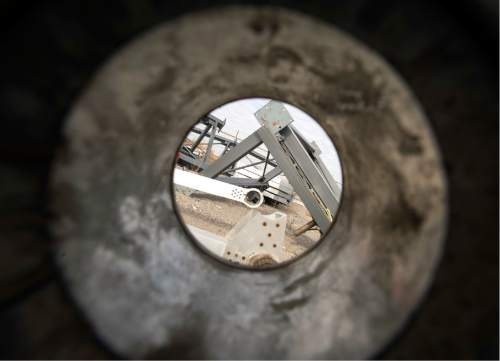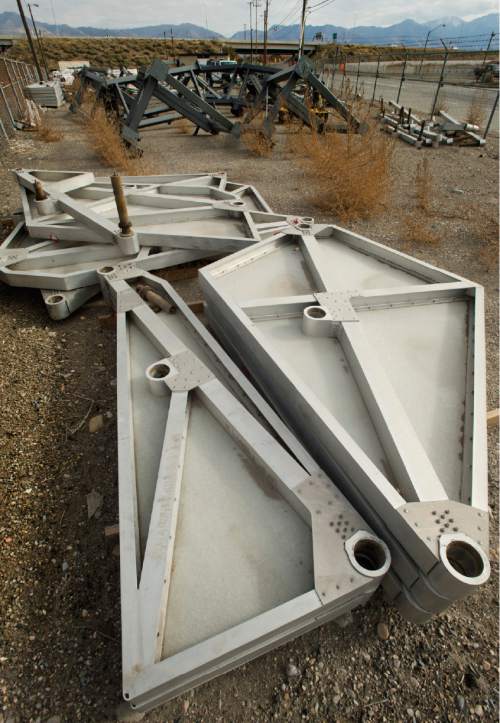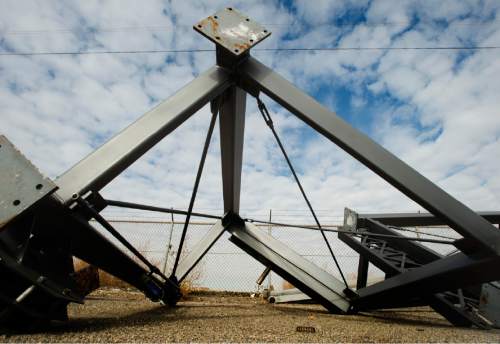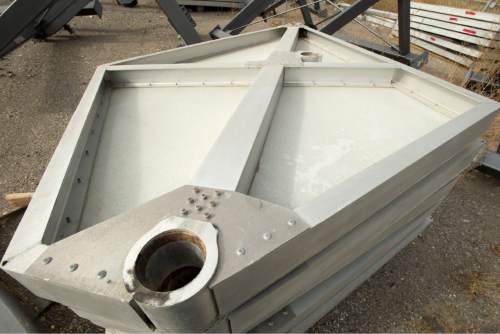This is an archived article that was published on sltrib.com in 2014, and information in the article may be outdated. It is provided only for personal research purposes and may not be reprinted.
Pieces of the Hoberman Arch — once the centerpiece of the 2002 Winter Games Medals Plaza — were stolen over the weekend from the Salt Lake City impound lot where the now-dismantled sculpture is being stored.
The stolen metal, police said, may be headed for a scrap yard.
At about 1:20 p.m. Saturday, a witness observed a man load several large metal pieces into a small white pickup that was outside the impound lot, located at 2350 W. 500 South, police reported.
The suspect was described as a white male adult, approximately 30 years old, wearing a plaid shirt and a black knit cap. A second suspect, a white female adult wearing a red sweatshirt, was driving the truck.
The vehicle was last seen heading west on 500 South. The witness did not get a license number.
Police said it was not immediately known how the suspects entered the yard.
Sgt. Robin Heiden said Monday there were no holes in the fence, meaning it was likely the suspects had climbed in and then thrown pieces of the arch over the fence.
Heiden said the metal was "probably stolen for scrap" and that detectives are likely talking to scrap metal dealers and asking them to be on the lookout for pieces of the sculpture.
The recent revelation that the arch was being stored at the impound yard has sparked controversy and concern.
Upon hearing in November about the present state of his creation, a somewhat-stunned Chuck Hoberman sighed, "Oh that's too bad."
In a telephone interview from his New York City office, Hoberman said the arch seemed to be a part of Salt Lake City and he had hoped it would be a continuing Olympic legacy.
"It brought a warm feeling to the community," he said. "I hope we can find a home for it."
When assembled, the phenomenal 31,000-pound aluminum web is 36 feet high and 72 feet wide. It opens and closes like the iris of an eye.
The University of Utah returned the arch to Salt Lake City last August to increase "flexibility" at Rice-Eccles Stadium, where it had been planted since 2003. The U.'s contract with Olympic organizers to keep the arch expired in 2009, U. spokeswoman Maria O'Mara said last month.
It cost the city $116,000 to tear it apart and move it to the impound lot.
Former Mayor Rocky Anderson, who presided over the 2002 Olympics as Salt Lake City's chief executive, said last month that he found the update on the arch "depressing."
"It's truly beyond belief that such a unique symbol of the Salt Lake Winter Games could be torn apart with the pieces lying in the city impound lot with no plan for what to do with it."
Anderson wanted the arch to be moved to Pioneer Park after the Games to be complemented with amenities such as an "Olympic garden" and ice rink.
But the City Council in 2002 wanted the arch moved to Gallivan Plaza on Main Street. That plan was nixed by International Olympic Committee rules, which wouldn't allow non-Olympic sponsors anywhere near the arch. Gallivan Plaza counts on such sponsors for various activities there.
In a last-ditch effort, the Salt Lake (Olympic) Organizing Committee — which had offered Salt Lake City $8 million toward an Olympic Park that included the arch — moved Hoberman's icon to the U. That location, on the south end of Rice-Eccles, however, prevented the arch from opening.
"Putting it at the university was a tragedy," Anderson said.
Former City Councilman Eric Jergensen, who originally favored the Gallivan Plaza location, has said the arch should be reconstructed close to downtown. That leaves few possibilities, but could include Pioneer Park or Warm Springs Park, 840 N. Beck St. (300 West), he said.
Relocating the icon is a challenge, Jergensen explained, citing location issues, budgetary demands and IOC sponsorship rules.
"But it's something the city should do," he said. "The discussion should continue and there are those [outside City Hall] who would be happy to participate in that discussion."
Salt Lake City Mayor Ralph Becker's spokesman Art Raymond has said finding a place for the Hoberman Arch is a challenge because, among other things, it must be easily seen by residents and tourists, but also must be secure from vandalism.
"There is hope for a permanent location for this Olympic icon," he said.
"And we hope there is money found to maintain it," added Raymond, referring to the City Council that holds the city's purse strings.
In February, City Council Chairman Charlie Luke said the city should establish an Olympic park.
"We have neglected that legacy," he said at the time. "It's an embarrassment."































